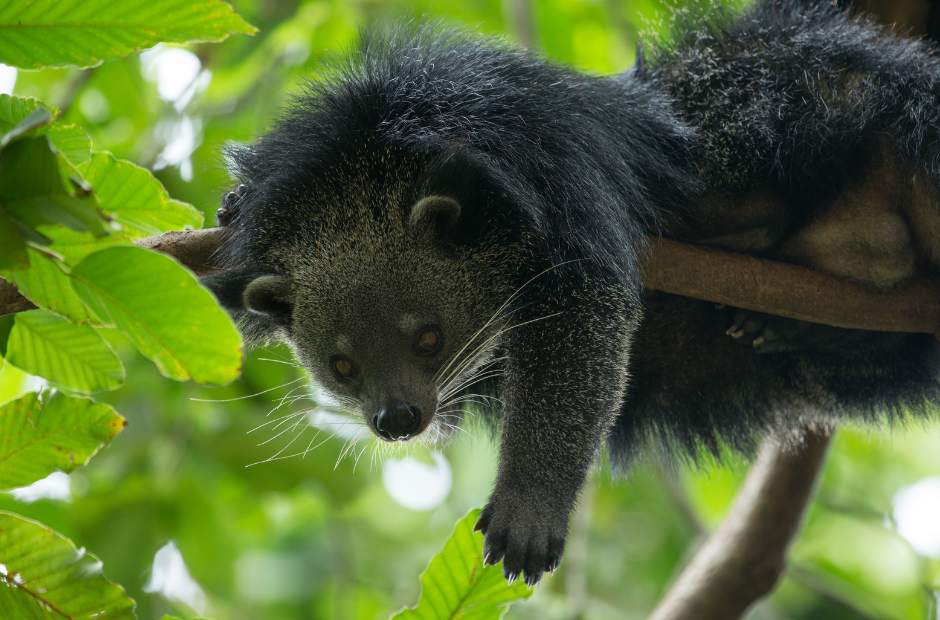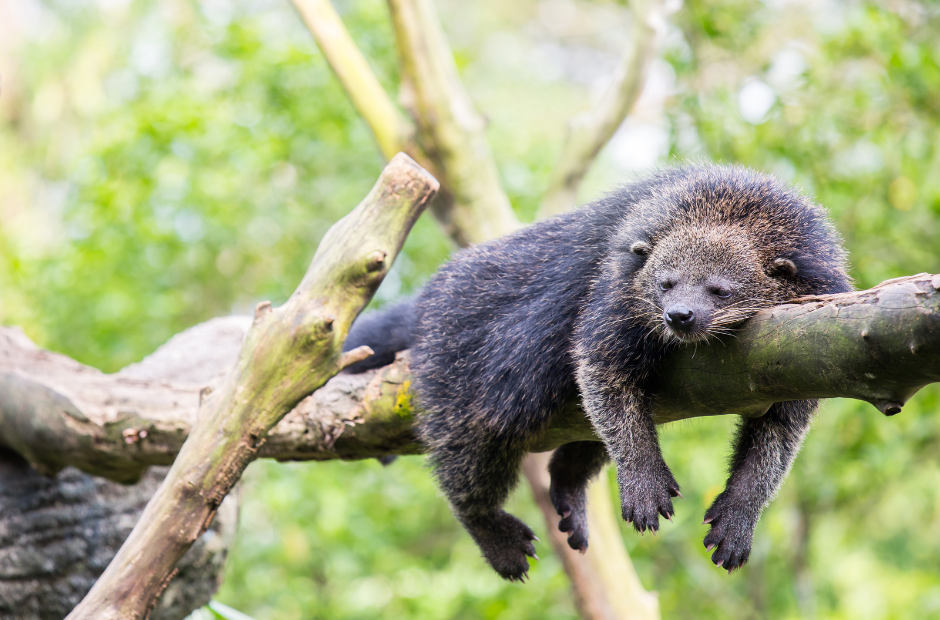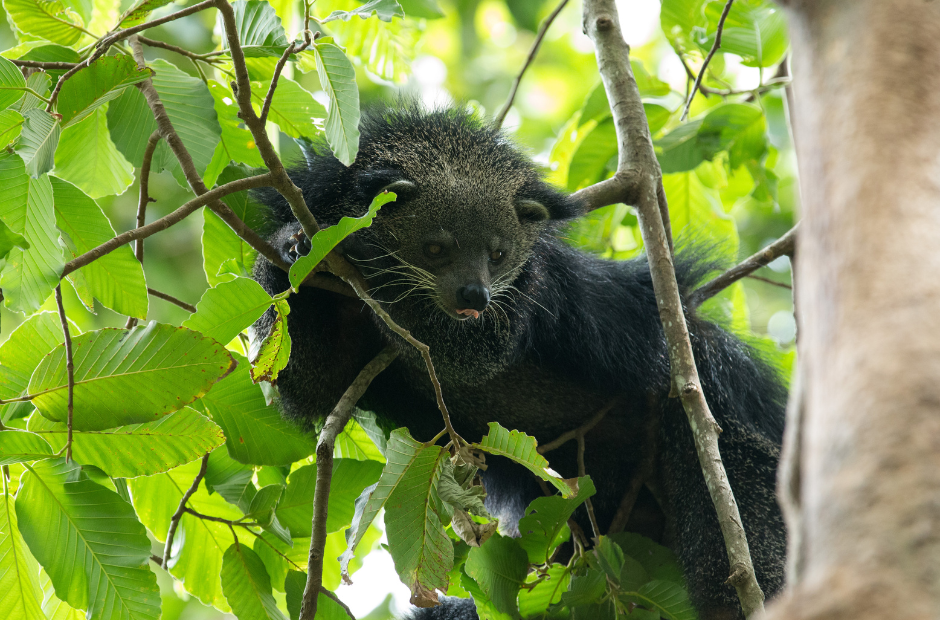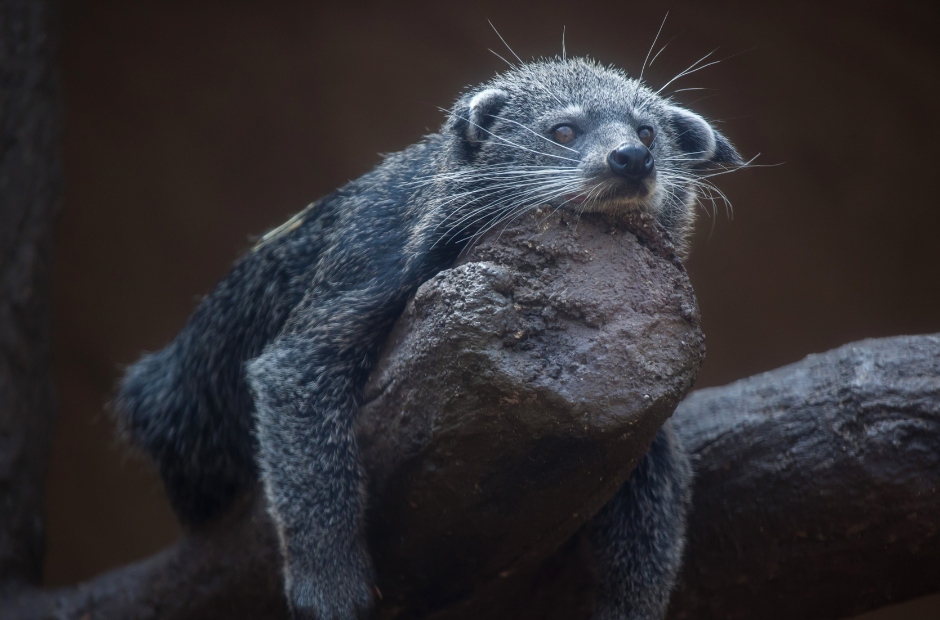
The binturong (Arctictis binturong), native to South and Southeast Asia, is a captivating creature that roams the lush tropical forests. Often referred to as the bearcat, this viverrid species has a distinctive appearance and intriguing behaviors.
Physical Characteristics
The binturong (Arctictis binturong) is a remarkable creature with several distinctive features:
- Shaggy Coat and Tufted Ears:
- The binturong’s long, shaggy hair gives it a rugged appearance. Its fur is typically black, with scattered whitish hairs.
- Tufted ears add to its charm, making it resemble a mix between a bear and a cat.
- Prehensile Tail:
- The binturong’s tail is prehensile, meaning it can grasp and hold objects. It can reach up to 90 cm (35 inches) in length.
- This tail is a valuable adaptation for an arboreal lifestyle, allowing the binturong to navigate treetops with agility.

Behavior and Diet
Understanding the binturong’s behavior sheds light on its survival strategies:
- Nocturnal and Crepuscular Habits:
- Binturongs are primarily active during twilight and nighttime. They rest during the day, hidden away in tree hollows or dense foliage.
- Their large, round eyes help them see well in low light conditions, aiding their nocturnal foraging.
- Diverse Diet:
- Binturongs are opportunistic feeders. Their diet includes:
- Fruits: They consume a variety of fruits, with figs being a favorite.
- Eggs: Binturongs raid bird nests for eggs.
- Small Animals: They occasionally hunt small mammals and birds.
- Their slow and deliberate feeding style allows them to carefully select their food items.
- Binturongs are opportunistic feeders. Their diet includes:
- Scent Marking and Communication:
- Binturongs have scent glands near their tail base. They rub this musky scent on trees and branches to mark their territory.
- This behavior also serves as a form of communication, conveying information to other binturongs about their presence and boundaries.

Conservation Status
The binturong faces threats to its survival:
- Vulnerable Species:
- The International Union for Conservation of Nature and Natural Resources (IUCN) classifies the binturong as vulnerable.
- Despite its wide geographic range across Southeast Asia, populations have been declining since the 1980s.
- Habitat Loss and Deforestation:
- Oil palm plantations in Indonesia and Malaysia contribute to habitat loss.
- In northern regions, deforestation and hunting pressure further endanger binturongs.

Some intriguing facts about the binturong’s behavior:
- Scent Marking and Communication:
- Binturongs have a unique way of marking their territory. They possess scent glands near their tail base that emit a musky odor. They rub this scent on trees and branches, leaving a distinct trail for other binturongs to follow.
- This scent-marking behavior also serves as a form of communication, allowing them to convey information about their presence, reproductive status, and territory boundaries.
- Arboreal Lifestyle:
- Binturongs are excellent climbers. Their prehensile tail provides stability as they move through the forest canopy.
- They spend most of their time in trees, rarely descending to the forest floor. Their strong limbs and sharp claws allow them to navigate treetops with ease.
- Nocturnal Habits:
- These creatures are primarily nocturnal, meaning they are most active during the night. They rest during the day, hidden away in tree hollows or dense foliage.
- Their large eyes help them see well in low light conditions, aiding their nighttime foraging.
- Diet and Feeding Behavior:
- Binturongs are omnivorous. Their diet includes fruits (such as figs), leaves, small mammals, birds, eggs, and insects.
- They have a slow and deliberate feeding style, carefully selecting their food items. Their strong jaws and sharp teeth allow them to crack open hard-shelled fruits.
- Social Structure:
- Binturongs are generally solitary animals. They come together only during mating season.
- Males and females communicate through vocalizations, including grunts, growls, and hisses.
- Curious and Playful Nature:
- Binturongs exhibit playful behavior, especially when they encounter novel objects or enrichment items.
- They are curious animals, investigating their surroundings and exploring new stimuli.
In summary, the binturong’s unique adaptations, behavior, and conservation status make it a captivating forest dweller. Let’s continue to appreciate and protect these mysterious creatures!

